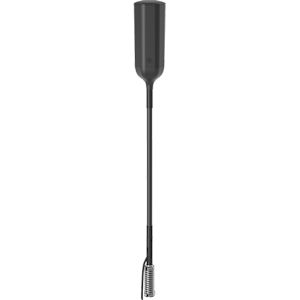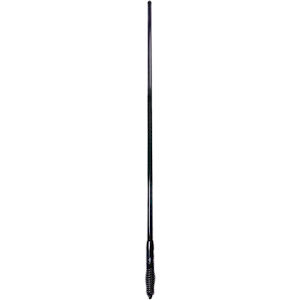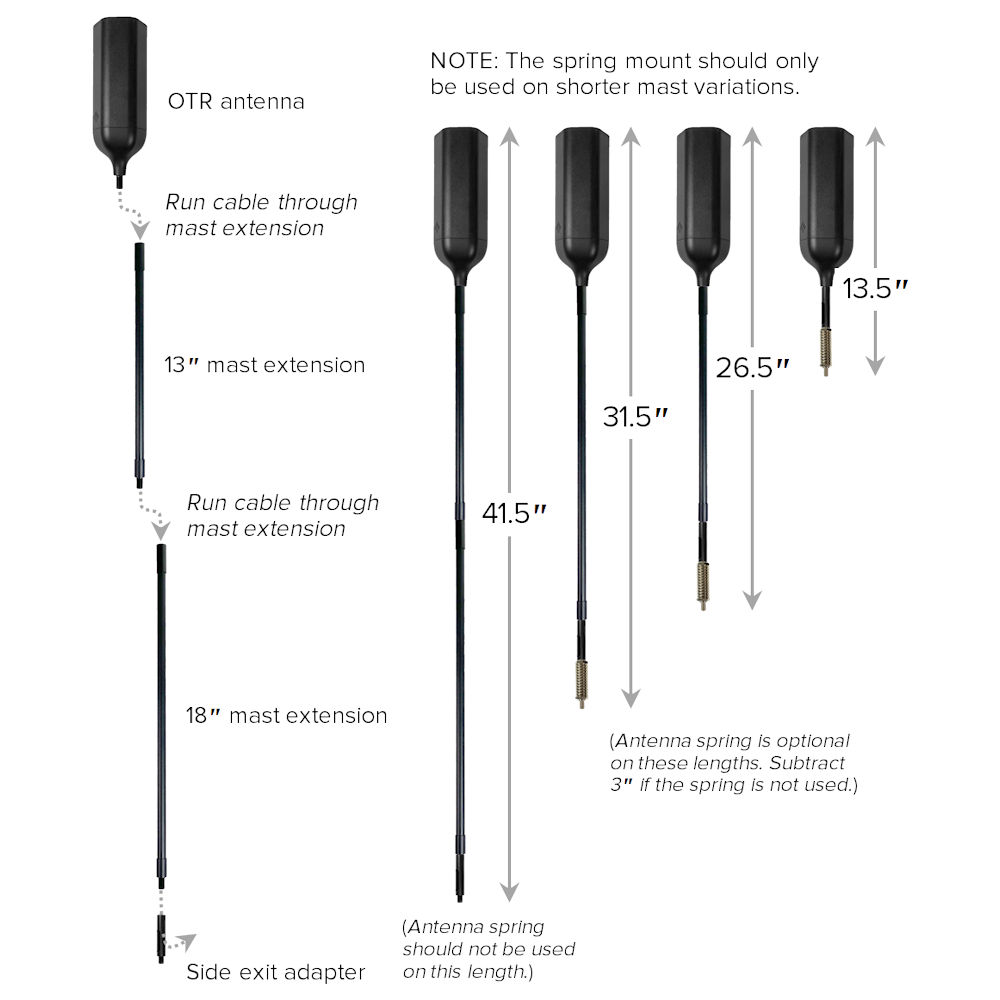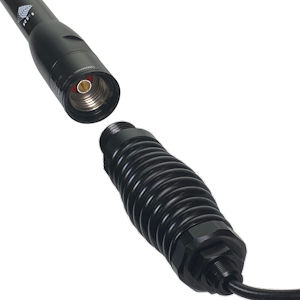What are the differences between the Wilson Drive OTR antenna and the RFI Q-Fit® 5G whip antenna?
Updated
The Wilson Drive OTR antenna (311229) is the latest design in Wilson Electronics’s long line of mast antennas for commercial OTR trucks. The RFI Q-Fit quick-release whip antenna (TS210721) has been used for years in the Australian Outback and recently became available in the United States.
Powerful Signal offers both of these antennas; this comparison will help you decide which one is best for your cellular reception needs.
Price
- Wilson Drive OTR: $119.99
- RFI Q-Fit: $279.99
The RFI Q-Fit antenna is $160 more than the Wilson Drive OTR due to its features, higher gain, and broader frequency range. (More on these below.)
How they’re similar
Some features of the Wilson Drive OTR and the RFI Q–Fit are identical or nearly identical. These include:
- Antenna type: Omnidirectional mast
- Works with vehicle types: Commercial/OTR trucks, RVs, service trucks, pickup trucks, and SUVs
- Spring base: Included (use of the spring is optional on the Wilson Drive OTR)
- Coax cable: Included (different cable types; similar lengths)
The Wilson Drive OTR and the RFI Q-Fit are both capable antennas that may be used in similar types of vehicles.
Where they differ
Frequency range
- Wilson Drive OTR: 698–2700 MHz
- RFI Q-Fit: 698–3800 MHz
The Wilson Drive OTR antenna operates on bands of cellular frequency that are used by most cell phone signal boosters.
The RFI Q-Fit antenna offers a greater frequency range that includes band n77 (C-band) and band n48 (CBRS) 5G cellular frequencies. This makes the RFI antenna more “future proof”—capable of operating with 5G boosters that will come into widespread use if they receive operational approval from the FCC.
Gain
Gain describes how efficient an antenna is at sending and receiving signals in a specific direction. Antenna gain is measured in dBi (decibels over isotropic), which is logarithmic.
The RFI Q-Fit antenna has 2½ times the gain of the Wilson Drive OTR antenna in the lower bands of cellular frequency—the ones that travel the farthest and that you’re most likely to receive in remote areas. The more signal a cell signal booster receives from its antenna, the more it’s able to amplify that signal.
All else being equal, the higher-gain RFI Q-Fit antenna will provide stronger signal inside your vehicle and allow you to operate at a greater distance from a cell tower.
Construction
- Wilson Drive OTR: ASA plastic (acrylonitrile styrene acrylate)
- RFI Q-Fit: Fiberglass
Both antennas are made of sturdy materials that withstand adverse weather conditions.
Radiator design
The radiator is the active part of the antenna that sends and receives signal to and from the cell tower.
- Wilson Drive OTR: 73⁄8″ × 2¾″ node at the top of the mast
- RFI Q-Fit: Entire 38″ length of the antenna
The Wilson Drive OTR has a cylindrical radiator at the top of the mast that sends and receives signal. This allows you to connect the bottom of the mast below the roof line of your vehicle; the antenna will function as long as the radiator is above the roofline and has a clear line of sight all around it.
The RFI Q-Fit antenna contains coupled Meander™ radiating elements that run the entire length of the antenna. These circuits provide stronger and more consistent gain, coverage pattern, and bandwidth. Because of this design, the RFI antenna works effectively only when it has a clear line of sight from top to bottom.
Coax cable
- Wilson Drive OTR: 16.0′ LMR195
- RFI Q-Fit: 16.4′ RG58
Both antennas have similar lengths of thin, flexible coax cable that run to and connect to your cell phone signal booster.
The Wilson Drive OTR’s LMR195 coax cable has 25% less signal loss over its 16-foot run than the RFI Q-Fit’s RG58 has over its 16.4-foot run. The RFI’s higher antenna gain compensates for that that difference, however, especially in lower frequencies.
Connector
- Wilson Drive OTR: SMA-female with SMA-male adapter
- RFI Q-Fit: SMA-male
The cables on both antennas are terminated with connectors that can be threaded through a small 0.4″ (10 mm) hole.
The Wilson Drive OTR antenna’s SMA-female connector includes adapters that will connect to cell signal boosters that have an SMA-female connector.
The RFI Q-Fit antenna’s SMA-male connector connects natively to boosters with SMA-female connectors.
Adapters for boosters with FME-male connectors (TS451036) and SMB-female connectors (TS451039) are available for use with either antenna.
Marine version
- Wilson Drive OTR: none
- RFI Q-Fit: RFI Q-Fit quick release marine antenna (TS210702)
RFI has a matching antenna in white with a marine mount for use on boats and ships.
Best uses
- Wilson Drive OTR: When you need flexible antenna height
- RFI Q-Fit: When you want the best possible signal gain and/or easy setup and takedown
The Wilson Drive OTR is the better choice if you need a specific antenna height to meet clearance requirements or if you can only run the antenna radiator 8 to 14 inches above the roof line of your vehicle. Wilson’s modular approach to its antenna design makes the Drive OTR the more flexible option for different vehicle heights.
The RFI Q-Fit is the better choice is you want the best performance from your outside antenna and need to connect to the weakest and most distant cell towers. It’s also the best option if you need the ability to remove your antenna for overhead clearance purposes.





